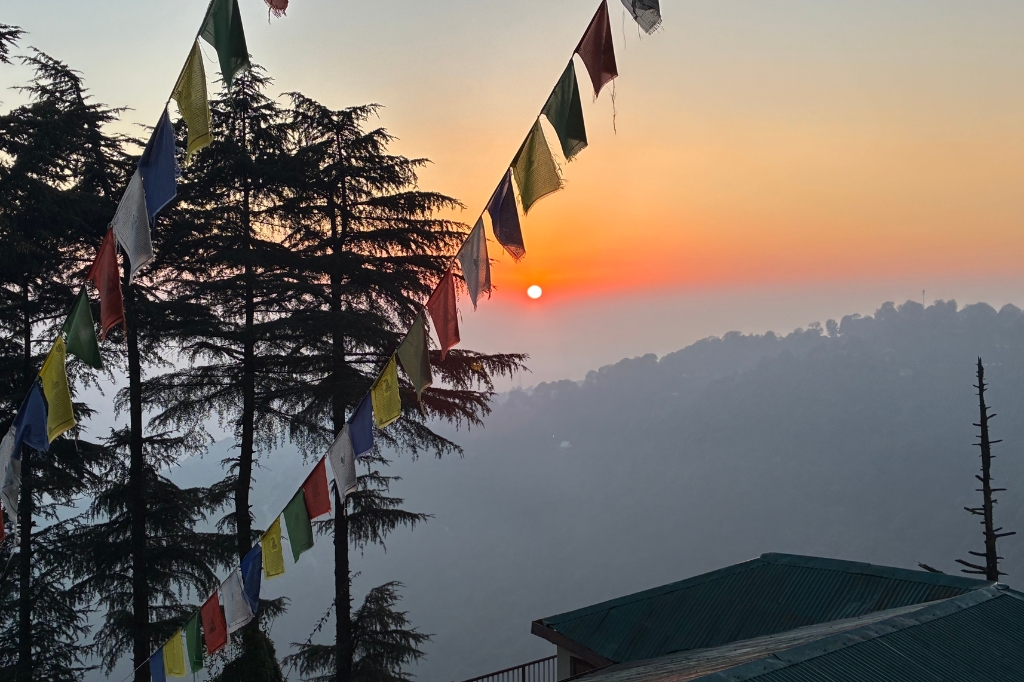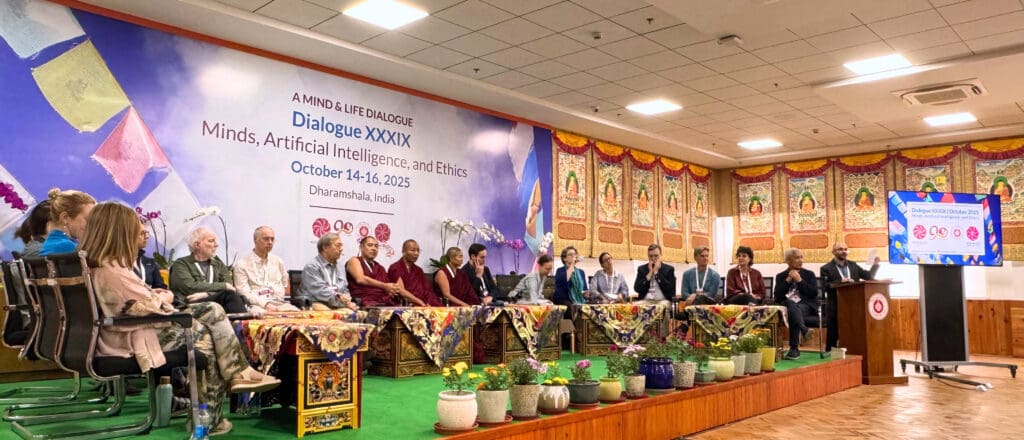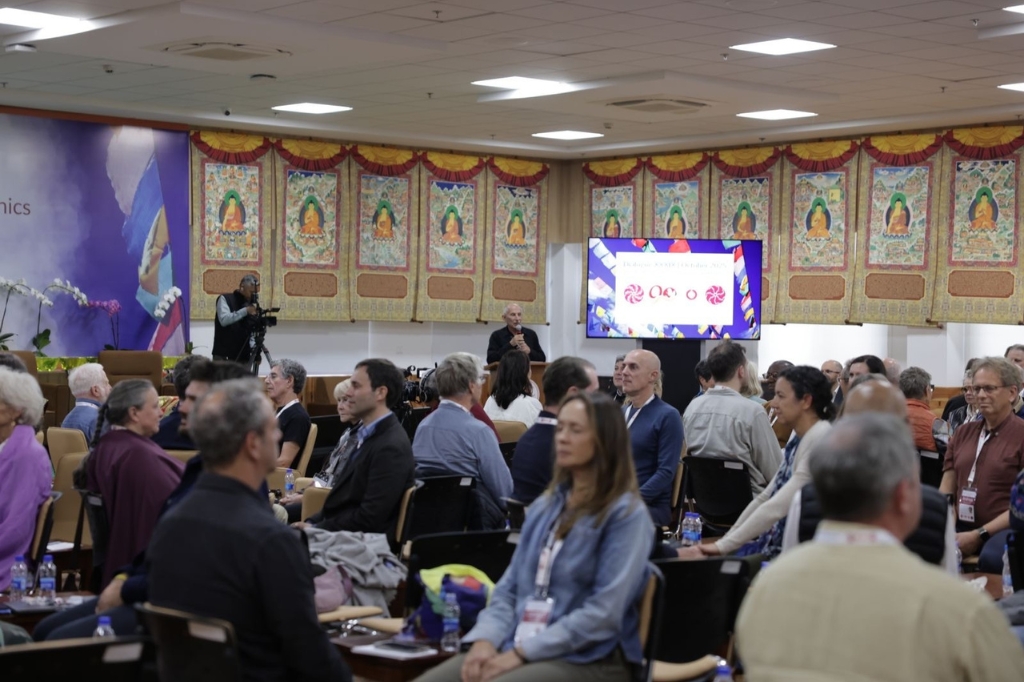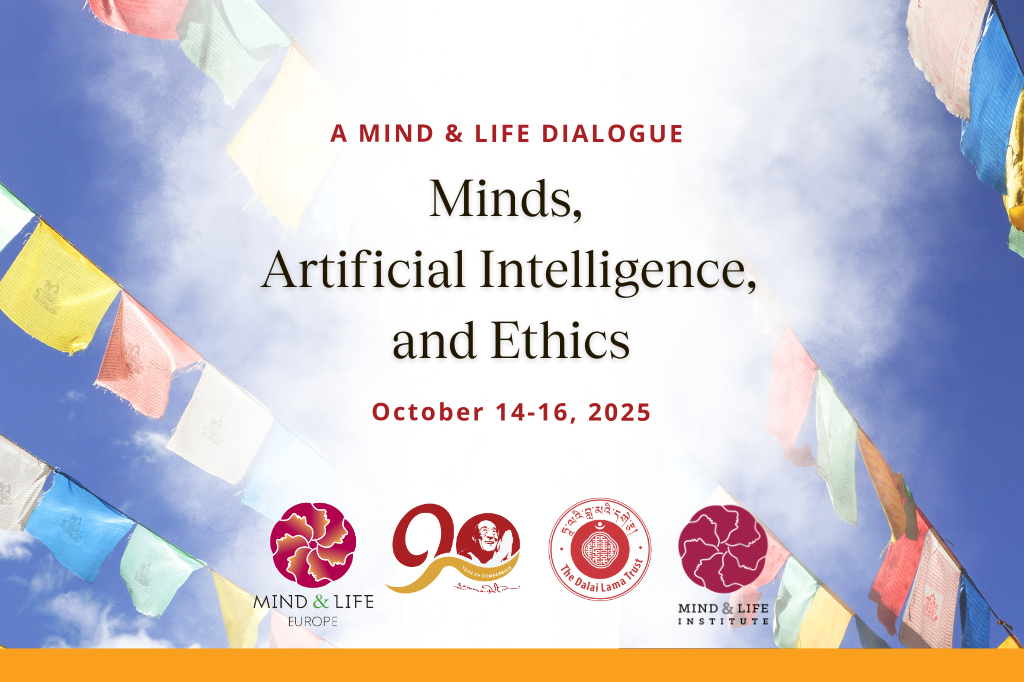
High on a mountain carved by winding paths, the Himalayas opened before us. It was an image so startlingly beautiful it almost felt like hands had reached out to shake me awake—an invitation to pause in wonder, to breathe, to remember the stillness we carry within but so often lose in the rush of our days. I remember feeling, with immense gratitude, that I was here.
The 39th Mind & Life Dialogue brought together around a hundred participants to spend a week thinking deeply about “Minds, Artificial Intelligence, and Ethics.” We arrived in Dharamshala as scientists, monastics, philosophers, entrepreneurs, policymakers, and practitioners. I was full of curiosity and excitement to be reunited with dear friends, old and new. Five key themes shaped the Dialogue, each sparked by a bold inquiry: What is intelligence? How might a more complex understanding of intelligence impact the AI systems we develop and the regulations we put in place? Is it possible to embed ethical values into AI?

Against the backdrop of His Holiness the Dalai Lama’s 90th birthday year, we were called to embrace his legacy and lifelong effort to promote human flourishing, and to explore how science and spirituality might serve humanity.
On the Dialogue’s first day, we were also invited to honor others who came before—the leaders and visionaries who, alongside His Holiness, planted the seeds of the Mind & Life Institute: the scientist and philosopher Francisco Varela and the lawyer-entrepreneur Adam Engle. Together, their vision and hard work widened the horizons of scientific inquiry, creating space for an entirely new field to emerge—contemplative science.
In his welcome, Thupten Jinpa, Buddhist scholar and Chair of the Board of the Mind & Life Institute, reminded us about the importance of setting clear intentions, as we often do when starting a meditation practice. We were also invited to bring gratitude for all those who directly or indirectly created the conditions that allowed us to be there together at that moment in time—a reminder of the vast, unseen network that sustains us from moment to moment.
Although I wish to celebrate each person present in the Dialogue and the depth of their contributions, I couldn’t possibly do them all justice. Instead, I hope to convey the essence of my experience and its impact on me. I invite you to watch the videos of this remarkable gathering, and look deeply into your own experience with each speaker and each topic. Even better: I encourage you to watch them with a friend or family member, and discuss your insights and lingering questions.
When I reflect on how I arrived where I am today, I recognize the immense role Mind & Life has played in my path: opening doors, connecting me with people and community. At every in-person gathering, I am especially enchanted by the conversations that happen between sessions—at daybreak over a first cup of coffee or at nightfall, bursting with insights and questions from the day. This is where we come together as people, beyond our identities and the labels we use to describe ourselves and one another. These are the precious moments of Mind & Life events when we get to share our stories and coauthor new ones.
Each day of our week together, Dharamshala invited me deeper into contemplation—from the early-morning practices that began our days, to the walks behind the monastery along the forest path known as the kora, talking about science, meditation, and life. We paused constantly to appreciate the mountains and their power to bring us back to the here-and-now. Dharamshala is a place where the flow of people, cars, motorcycles, and animals all intertwine—where at night the streets bustle with cab drivers and shop owners, nuns walking home, monkeys chasing each other across the rooftops, cows resting in intersections, and wounded dogs hoping to be noticed by a kind stranger. It is a place where contrasts expose human suffering and human flourishing side by side.
On the second afternoon, Peter Hershock reminded us that “individual existence is an illusion.” We are constantly and deeply impacted by others and by everything that surrounds us, including technology and AI, even if we deliberately try not to use them. His talk was, for me, a timely reminder of our interconnection, interdependence, and oneness at a time when it is so easy to feel separate, different, fractured, and afraid. This day especially stands out in my memory, crystalized by the powerful meditation practice led by Jack Kornfield, where we looked deeply into another person’s eyes for almost thirty minutes, noticing them fully, seeing them as a young child and then as an elder, gazing into our own infinite nature.

Of course this non-separation has been one of the central teachings His Holiness has offered throughout his life. In all past Dialogues, His Holiness was physically present every day, at the very heart of the conversations with scientists and philosophers. This year, we felt his absence—and at the same time, he was present through the monastics who carry forward his legacy, such as His Eminence Khangser Rinpoche, Geshe Lodoe Sangpo, Geshe Thabkhe, and Venerable Ani Choyang. It was such an honor to receive their compassionate wisdom on this year’s theme. And meeting His Holiness on the final day, we sensed that he had been with us the whole time.
As a neuroscientist and clinical psychologist, AI is present in every part of my field. Clients are using AI as therapists, researchers are using AI to write papers, and students are learning with AI-generated summaries rather than books. AI is already woven into our lives, often without our awareness or consent, shaping how we study, work, and relate to ourselves and others. And while it connects us to vast possibilities, it can also distance us from one another, making it harder to stay close to the complexity and frustration that human life inevitably brings.
What is fundamental in human relationships? What drives change for those seeking help in moments of suffering? The therapeutic relationship, grounded in empathy, compassion, and trust, remains essential. Anat Perry shared her research on empathy and AI, and the results are remarkable, showing us that AI is capable of mimicking some aspects of empathy but struggles with others, perhaps because it lacks what is most human in us: embodied presence, lived experience, subjectivity, and finite attentional resources.
Technology, and especially AI, may have the potential to relieve suffering and bring great benefit—-especially as we navigate ever-increasing demands on our time, our attention, and our bodies. Yet the monastics challenged us to also consider how such technologies might strip us of the deeper growth that comes through dedicated inquiry and critical thinking. In a culture of urgency, the instant availability of answers may reinforce the idea that waiting is unnecessary. And I find myself wondering about the importance of waiting, of nurturing the vitality and wonder that lives in the space between question and answer, or in the long pause between a client’s vulnerable moment and a therapist’s response. I left the dialogue with more questions than answers but one thing seems clear to me: If AI is to serve human flourishing, then perhaps the ethical call to action is not only to regulate the tool, but to protect what makes us human, to work on our freedom of attention and intention, and to care for our minds and the values that are shaping these technologies.
In our rush to harness the power of AI, may we not lose our capacity to pause, to wait, to feel, to relate, to be moved, to be with the unknown. May we preserve the depth and mystery that no algorithm can replicate.
Geissy Araújo, PhD is a Neuroscientist, Clinical Psychologist, and Educator working on the intersection of contemplative practices and psychedelics as ways of promoting human flourishing.


